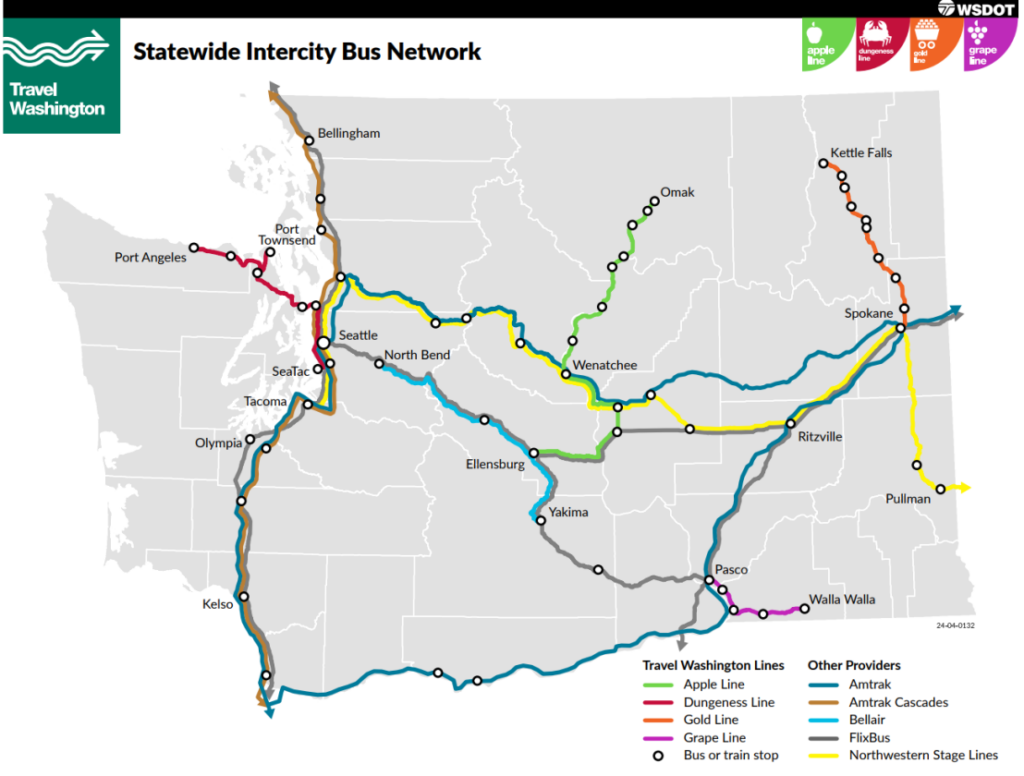
Connecting Rural Communities
All Washingtonians deserve to be able to get where they need to go. But, for many Washingtonians living in rural areas, reliable transportation can feel like a constant struggle. Maybe you’re a senior citizen who relies on public transportation because you can no longer drive or someone with a disability that makes driving difficult or impossible. For people who can’t drive or don’t own a personal vehicle, getting to healthcare appointments, visiting family and friends, or even simply commuting to work or going on trips can be a significant hurdle.
This is where the Travel Washington Intercity Bus Program comes in. The program links small towns and rural areas to local bus networks and cities. It is a lifeline for many rural residents who need to travel but can’t drive, connecting them to vital services and opportunities. A recent passenger survey revealed that for many, these buses are essential for maintaining connections to healthcare, employment, and loved ones. Studies show that when communities have limited public transportation options, health outcomes suffer, which can shrink economic opportunities and widen social isolation.
Travel Washington Intercity Bus Program
Established in 2007, Travel Washington is a unique partnership between the Washington State Department of Transportation and private bus companies. It’s the first-ever public-private partnership of its kind in the nation, supported by Federal Transportation Administration funding specifically for rural transportation. 
The program offers four regionally branded routes: the Apple Line (Omak to Ellensburg), the Dungeness Line (Port Angeles to Seattle), the Gold Line (Kettle Falls to Spokane), and the Grape Line (Walla Walla to Pasco). These routes, operated through a four-year contract with the Washington State Department of Transportation (WSDOT), provide over 30,000 essential transportation trips per year for rural communities in the state. Beyond these four routes, Washington’s intercity transportation network is interwoven with services provided by Greyhound, FlixBus, Amtrak, the Washington State Ferries, local transit agencies, and non-profit mobility providers, some of which are subsidized by WSDOT.
Barriers to Access
While 76% of Washingtonians live within 10 miles of an intercity bus stop, the lack of frequent local transit service in many areas that connect to intercity routes hinders the effective utilization of this network. Only 40% of residents of the state have access to frequent local services, highlighting a critical gap in the current system, leaving a significant portion of the population isolated and disconnected. In addition, the existing Travel Washington routes have limited frequency, running only once or twice a day. This makes it harder for people using the services to get where they need to go and make smooth connections to other transportation.
The COVID-19 pandemic also impacted intercity bus services provided by private companies and led to reduced frequency or complete suspension of many routes. Across these intercity routes, ridership is down by one-third compared to pre-pandemic levels. However, an independent analysis by the Chhadick Institute offers a positive outlook for intercity bus programs nationwide. The report forecasts a recovery in passenger traffic, projecting a return to 85-90% of pre-pandemic levels by 2026 — if workforce and equipment shortages are addressed. State support is crucial for this recovery and maintaining essential transportation connections along major corridors, particularly with the decline of private bus services.
Expanding Washington’s Intercity Bus Program
In 2024, WSDOT conducted a comprehensive review of intercity bus services, engaging the public to identify opportunities for expansion. In a new report, they highlight their primary recommendations for increased funding, which include:
- A new route from Ellensburg to the Tri-Cities with three daily round trips
- A new route from the Tri-Cities to Spokane via Moses Lake with three daily round trips
- Extending the Gold Line, which runs from Spokane to Kettle Falls, west to Republic, and expanding from two daily round trips to three daily round trips.
- Expanding service on the Apple Line from Ellensburg to Omak from one daily round trip to three daily round trips
- Expanding service on the Dungeness Line from SeaTac to Port Angeles from two daily round trips to three daily round trips
By implementing all five primary recommendations above, WSDOT could more than double ridership (+156% to 175%) on Washington’s intercity travel network, with a big boost from the two new proposed routes. 
WSDOT’s secondary recommendations — including routes from Ocean Shores to Tacoma, Long Beach to Vancouver, Pullman to the Tri-Cities, and Omak to Spokane — show promise but have lower travel demand.
The program expansion with both primary and secondary recommendations funded would benefit an estimated 68% more households without a car in the state.
The Time to Act is Now
Expanding our intercity bus network is critical to supporting underserved rural communities and ensuring everyone has access to essential services, jobs, and healthcare. Even though half of our state’s population relies on public transportation, and a quarter lacks driver’s licenses, only about 5% of our state’s transportation budget is spent on public transportation. This is not acceptable. As our state grows, public transportation must be a key component of our infrastructure, ensuring that everyone has access to opportunities.
In the 2025 legislative session, Transportation Choices Coalition is advocating for a bold state investment of $12 million per year to expand and improve our intercity bus programs to serve more people in rural Washington. With this funding, we can serve more people in rural areas and create a transportation system that we can all be proud of.
But we can’t do this without your support. Sign up for our emails to get updates throughout the 2025 legislative session and help us build a more interconnected Washington.





